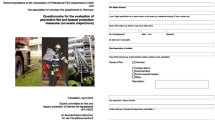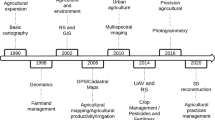Abstract
The technology that has been developed for real-time analysis of the lightning-caused forest fire risks is discussed. Comparative estimates of the number and areas of such fires are obtained for Russia’s regions. The zone of localization of lightning-caused fires is identified through the use of the GIS capabilities.
Similar content being viewed by others
References
Uman, M.A., Lightning, New York: McGraw-Hill, 1969.
Shindo, T. and Uman, M.A., Continuing Current in Negative Cloud-to-Ground Lightning, Journ. Geophys. Res., 1989, no. 94 (D4), pp. 5189–5198.
Korovin, G.N. and Andreev, N.A., Aviation Forest Fire Control, Moscow: Agropromizdat, 1988 [in Russian].
Ivanov, V.A., Lightning-Caused Forest Fires on the Yeniseiskaya Plain: Author’s Abstract Cand. Sci. Degree (Agriculture) Dissertation, Krasnoyarsk, 1996 [in Russian].
Ivanov, V.A., The Mechanism for Lightning-Caused Forest Flash Fire, Sibirskii ekologicheskii zhurnal, 1996, vol. 3, no. 1, pp. 103–107 [in Russian].
Filippov, A.Kh., Thunderstorms in East Siberia, Leningrad: Gidrometeoizdat, 1974 [in Russian].
Flannigan, M.D. and Wotton, B.M., Lightning-Ignited Fires in Northwestern Ontario, Canada Journ. Forest Research, 1991, no. 21, pp. 277–287.
Latham, D. and Williams E., Lightning and Forest Fires, in Forest Fires: Behavior and Ecological Effects, San Diego: Academic Press, 2001.
Forest Fires: Behavior and Ecological Effects, Ed. by Johnson E.A. and Miyanishi K., San Diego: Academic Press, 2001.
Stol’archuk, L.V., Forecasting and Assessment of Fire Hazard in Forest, Leningrad: Izd-vo LenNII lesnogo khoz-va, 1982 [in Russian].
Korshunov, N.A., Lightning-Ignited Forest Fires on the Territory of the Krasnoyarsk Angara Region: Author’s Abstract Cand. Sci. Degree (Agriculture) Dissertation, Krasnoyarsk, 2002 [in Russian].
Ivanov, V.A., Methodological Foundations of a Classification of Forests in Middle Siberia From the Degree of Lightning-Caused Fire Hazard: Author’s Abstract Dr. Sci. Degree (Agriculture) Dissertation, Krasnoyarsk, 2006 [in Russian].
Kourtz, P. and Todd, B., Predicting the Daily Occurrence of Lightning-Caused Forest Fires, in Information Report PI-X-112 Petawawa National Forestry Institute Forestry, Canada, 1991.
Ponomarev, E.I., Ivanov, V.A., and Korshunov, N.A., TOVS Satellite Data With Applications to the Problem of Forecasting Lightning-caused Fire Hazard, Geografiya i prirod. resursy, 2006, no. 1, pp. 147–150 [in Russian].
Ershov, D.V., Korovin, G.N., and Podol’skaya, A.S., Lightning-Caused Fire Risk Assessment Using the Thunderstorm Location System, in Fires in Forest Ecosystems of Siberia, Krasnoyarsk: Izd-vo In-ta lesa SO RAN, 2008 [in Russian].
Kutsenogii, K.P., Samsonov, Yu.N., Churkina, T.V., et al., Content of Trace Elements in Aerosol Emission During Fires in Boreal Forests of Central Siberia, Optika atmosfery i okeana, 2003, vol. 16, nos. 5–6, pp. 461–465 [in Russian].
Author information
Authors and Affiliations
Corresponding author
Additional information
Original Russian Text © E.I. Ponomarev, 2011, published in Geography and Natural Resources, 2011, Vol. 32, No. 1, pp. 150–154
Rights and permissions
About this article
Cite this article
Ponomarev, E.I. Assessing the lightning-caused forest fire risks through the use of the GIS-oriented technology. Geogr. Nat. Resour. 32, 72–75 (2011). https://doi.org/10.1134/S1875372811010124
Received:
Published:
Issue Date:
DOI: https://doi.org/10.1134/S1875372811010124




